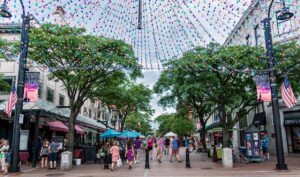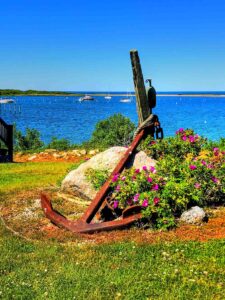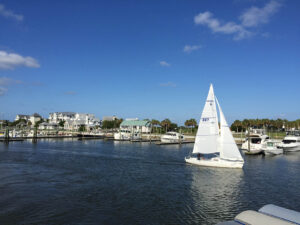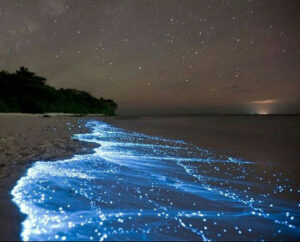Many a sailor’s image of cruising Cape Cod is that of a Sunday idyll with President John F. Kennedy and First Lady Jackie wearing fashionably nautical togs as they day sailed in a light breeze. Cruising Cape Cod can be all that, and more. The “more” being the importance of awareness of strong tidal currents, fog, sand bars and changes in the wind. Becoming familiar with local current tables can make the difference between an enjoyable day on the water and a frustrating one.
Cape Cod is shaped like an arm with its biceps being flexed. Just think of the old cartoon of Popeye the Sailor Man after he eats his spinach. The fist is Provincetown, with its Key West-style charm, located on Cape Cod Bay. The forearm has the Cape Cod National Seashore open to waves rolling in off the Atlantic on one side and the protected harbor of Wellfleet on the bay side. Chatham is the elbow. The biceps includes the Cape’s well-known harbors of South Yarmouth, Hyannis, and Falmouth on Nantucket Sound, and Barnstable on Cape Cod Bay. Where the biceps and shoulder meet is the shortcut, known as the Cape Cod Canal, between Cape Cod Bay and Buzzards Bay.
PROVINCETOWN
Known as P-Town for short, this enclave is a haven for artists in every medium: painting, sculpting, theater, writing and music. It prides itself as America’s oldest continuous art colony, and welcomes visitors of every stripe. Diversity is an essential part of life in P-Town, and it has grown into a welcoming place largely built around, and by, the gay and lesbian community. In fact, there is a Provincetown-Key West axis. Boaters who visit the Keys in the winter should not be surprised when they find their favorite Key West bartenders and wait staff working in P-Town in the summer.
Arriving by sea, the Pilgrim Monument is the first thing seen on approaching Provincetown. Standing at 252 feet tall, this granite tower commemorates the first landfall in the New World by the Mayflower in 1620. In the harbor, below the monument, Provincetown Marina (ptownmarina.com, 508-487-0571; fuel dock located on site) offers transient guests 100 slips accommodating vessels up to 300 feet and 85 moorings with a launch service.
WELLFLEET
With beautiful beaches on both the bay and Atlantic sides, Wellfleet (the name of which is thought to have come from “Whale Fleet”) is also endowed with clear spring-fed ponds. These ponds are called kettle holes and were created by glaciers several thousand years ago. Renowned for the mild, sweet oysters that grow in the estuaries of Wellfleet Harbor, this village has a quaint town center dotted with classic white-clapboard New England–style homes and sophisticated art galleries.
Wellfleet Marina (wellfleet-ma.gov, 508-349-0320) is tucked away at the northern end of the harbor. Although this municipal marina only has five slips and five mooring balls available for visiting yachts, reservations can be made ahead of time.
BARNSTABLE
The village of Barnstable lies along Barnstable Harbor off Cape Cod Bay. Founded in 1638, it became the second-oldest area of the cape to be settled by Europeans. The sheltered waters of the harbor became the center of a prosperous maritime trade that reached its height in the mid-19th century when clipper ships sailed from the village to the Orient. Wealthy sea captains built great houses along the roads leading to the harbor. Thanks to vigorous preservation efforts, these homes remain largely intact.
Sandy Neck, a long peninsula of sand that protects the harbor from the bay, has thousands of acres of pristine beaches, sand dunes, maritime forests and marshes to explore. Sailing in from Cape Cod Bay, after rounding Sandy Neck Light off Beach Point, follow the marked channel toward Maraspin Creek to dock at Barnstable Harbor Marina (townofbarnstable.ma.us,508-790-6273).
CAPE COD CANAL
In 1914, the same year that the Panama Canal opened to shipping, the Boston, Cape Cod and New York Canal Company began collecting tolls on a partially completed canal that promised to shorten the distance between New York and Boston by 54 nautical miles. Four years later near the end of World War I, a German U-boat shelled a tugboat and its four barges off Cape Cod. Within days the U.S. government took over operation of the Cape Cod Canal by presidential proclamation. Since that time, the Army Corps of Engineers has dredged and rebuilt parts of the canal and turned it into a free public waterway.
The Cape Cod Canal was the widest sea level canal of its time when reconstructed just before the outbreak of World War II. Today, the seven-mile long canal is 480 feet wide and 35 feet deep. The hydraulics of this artificial waterway makes it particularly noteworthy for the swift tidal currents that can reach 4.5 knots at maximum ebb. Safe harbor can be found near the Buzzards Bay entrance to the canal at Cataumet. Kingman Yacht Center(kingmanyachtcenter.com, 508-563-7136; fuel available onsite) is the largest full service marina on Cape Cod. With ample dockage for yachts up to 120 feet long and 130 mooring buoys available, transient vessels are welcomed.
HYANNIS
This historic village has been dubbed the heart of Cape Cod and is the gateway to the beautiful waters of Cape Cod, Nantucket and Martha’s Vineyard and more! All summer long there are activities for the entire family. Just stroll the vibrant village sidewalks, and walk to nearby beaches, restaurants and town. On the bustling Hyannis Main Street you’ll find lively nightlife, specialty shops, fine dining, fun attractions and much more. Hyannis Harbor is beautiful, well-protected and one of the few natural deep water harbors in the area and Hyannis Marina (hyannismarina.com, 508-790-4000; fuel available onsite) can accommodate everything from small boats, to deep draft sailboats and mega-yachts up to 220 feet in length. Hyannis Marina offers boaters world-class amenities and marine services, a large private pool, and two harborside restaurants serving fresh local seafood and libations.
CHATHAM
Pleasant Bay is a shallow estuary sheltered from the Atlantic Ocean by the ever-changing Nauset Beach, and Chatham is the gateway to this special natural environment that offers swimming, birdwatching, nature trails and fishing. Just south of Nauset Beach is the Monomoy National Wildlife Refuge consisting of North and South Monomoy Islands and a portion of Morris Island stretching out into Nantucket Sound.
Chatham Light, built in 1877, is a local landmark that was featured in the movie The Finest Hours about a heroic U.S. Coast Guard rescue. This active lighthouse is on the National Register of Historic Places and is open for tours. Popular Stage Harbor has a few small marinas, however, seasonal users claim most of the dock space and moorings. Transient boaters will have the best luck at the Monomoy Yacht Club (508-945-3766) with two overnight mooring balls available.
OCEAN VERSUS CANAL ROUTE
Approaching Cape Cod from Buzzards Bay en route to Provincetown, the prudent mariner has two choices: either follow Nantucket Sound across Pollock Rip Channel out into the Atlantic Ocean or transit the Cape Cod Canal into Cape Cod Bay. The decision depends on a thorough assessment of prevailing conditions, the seaworthiness of the vessel and the seamanship skills of the captain. Once the safest route is chosen, getting there is half the fun. The rewards along the way are encountering whales, dolphins, seals and sea turtles.
Capt. Jeff Werner has been in the yachting industry for over 25 years. In addition to working as a captain on private and charter yachts, both sail and power, he is a certified instructor for the USCG, US Sailing, RYA and the MCA. He is also the Diesel Doctor, helping to keep your yacht’s fuel in optimal condition for peak performance. For more information, call 239-246-6810, or visit MyDieselDoctor.com. All Marinalife members receive a 10% discount on purchases of equipment, products and supplies from Diesel Doctor.





